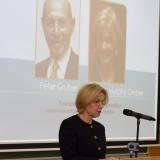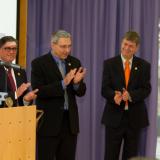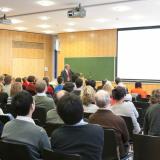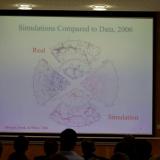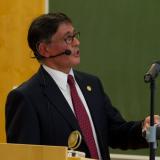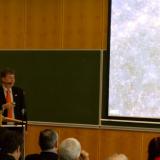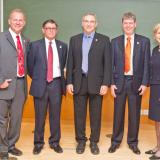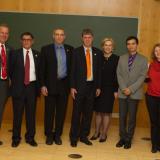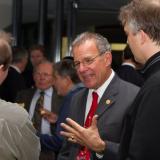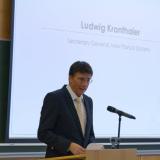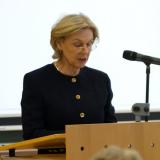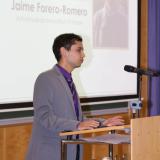2011 Gruber Cosmology Prize
In a series of pioneering papers in the 1980s that relied on numerical simulations, Marc Davis, George Efstathiou, Carlos Frenk, and Simon White provided a powerful new tool for comparing theory and observation on cosmological scales. They then used that tool to validate the “cold dark matter” theory of cosmic growth. Today virtually every aspect of astronomy relies on numerical simulations, and cold dark matter is a fundamental component of the standard model of cosmology.
2011 Cosmology Prize Recipients
Laureate Profile
The collaboration of Marc Davis, George Efstathiou, Carlos Frenk, and Simon White in the 1980s fundamentally transformed cosmology. Yet as is often the case in science, the collaborators set out to demonstrate the opposite of what they eventually discovered. In fact, they did so twice.
For three years in the late 1970s and early 1980s, Marc Davis, working at the Harvard-Smithsonian Center for Astrophysics (CfA), led the most ambitious galaxy survey to that time—2400 galaxies at various distances. “It produced amazing pictures that looked nothing like anything we had ever seen before,” says Davis.
Astronomers had assumed that the distribution of matter in the universe—galaxies—would be more or less uniform. Instead, the three-dimensional structure that emerged from the CfA survey revealed extraordinarily lengthy filaments of galaxy superclusters, separated by vast voids of space, as if the universe resembled a giant web.
How to explain this appearance? By the late 1970s, astronomers realized that they needed to invoke “dark matter” in order to account for galaxy motions that otherwise would be violating the laws of physics. The presence of prodigious amounts of invisible matter that would be interacting with visible matter also might explain why galaxies had clumped in greater concentrations than theorists had assumed. One species of particle seemed a strong candidate for the dark matter—the neutrino.
Davis, by now a full professor at the University of California, Berkeley, teamed up with Simon White to test the neutrino hypothesis. The two of them knew a British theorist, George Efstathiou, who had adapted numerical simulation techniques used in condensed matter physics and applied them to cosmology. Davis, White, and a postdoc, Carlos Frenk, figured that Efstathiou’s numerical simulations would demonstrate that the prevalence of neutrinos had caused the universe to evolve into a web.
The match between what neutrino simulations predicted and what CfA observations showed, however, was “just unbelievably bad,” says Davis. Even so, ruling out a theory is important. “It was our first really major result,” says White.
The neutrino was an example of what theorists called “hot dark matter,” because at early times it would travel at velocities approaching the speed of light and leave behind the “regular” matter. Theorists soon proposed an alternative theory: “cold dark matter,” relatively sluggish matter that would fall together to make galaxy halos, taking the regular matter along for the ride.
“Okay, let’s have a go at cold dark matter,” Frenk remembers thinking. Maybe they could rule out that theory, too.
Efstathiou now formally joined the collaboration. He and later also Frenk had access to an experimental network of computers that connected institutions all over England. Computer technology was still new enough that the network was in low demand. Even so, Efstathiou says, laughing, “We basically flooded the network.”
To the team’s surprise, this time the simulations closely matched the observations. Not only was cold dark matter a viable option, it became vital to any attempt to understand the growth structure in the universe.
From 1985 to 1988 the DEFW collaboration produced five papers that changed cosmology forever. The discipline now had a new means of discovery as well as a new model on which to exercise it—both of which have proven to be durable. Numerical simulations remain an essential tool for modeling and interpreting the structure and evolution of the universe on the largest scales. And cold dark matter has become one of two key components, along with dark energy (also anticipated by the DEFW results), of the standard cosmological model.
Watch Video
Citation
The Peter and Patricia Gruber Foundation proudly presents the 2011 Cosmology Prize to Marc Davis, George Efstathiou, Carlos Frenk and Simon White for their pioneering use of numerical simulations to model and interpret the large-scale distribution of matter in the Universe.
Cosmological simulations allow direct confrontation between observation and theory, and have transformed the way we conceive and visualize the growth of structure in the Universe.
The work of Professors Davis, Efstathiou, Frenk and White galvanized support for "cold dark matter" as the dominant form of matter in the Universe and has thus been instrumental in the crafting of our current cosmological paradigm.






